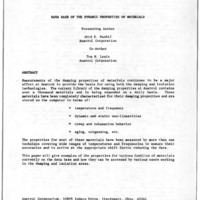-
Title
-
Data Base Of The Dynamic Properties Of Materials
-
Report Number
-
WL-TR-91-3078 Volume I, p. DBB-1 thru DBB-26
-
Creator
-
Nashif, Ahid D.
-
Lewis, Tom M.
-
Corporate Author
-
Anatrol Corporation
-
Laboratory
-
Wright Laboratory
-
Date
-
1991
-
Date Issued
-
1991-08
-
Extent
-
26
-
Contract
-
Laboratory Research - No Cotract
-
DoD Project
-
2401
-
DoD Task
-
240104
-
Identifier
-
ADA241311
-
Format
-
1 online resource
-
Abstract
-
Measurements of the damping properties of materials continues to be a major effort at Anatrol to provide the basis for using both the damping and isolation technologies. The current library of the damping properties at Anatrol contains over a thousand materials and is being expanded on a daily basis. Those materials have been completely' characterized for their damping properties and are stored on the computer in terms of:
* temperature and frequency
* dynamic and static non-linearities
* creep and relaxation behavior
* aging, outgassing , etc.
The properties for most of these materials have been measured by more than one technique covering wide ranges of temperatures and frequencies to ensure their accuracies and to arrive at the appropriate shift factor reducing the data. This paper will give examples of the properties for various families of materials currently on the data base and how they can be accessed by various users working in the damping and isolation areas.
-
Description
-
Measurements of the damping properties of materials continues to be a major effort at Anatrol to provide the basis for using both the damping and isolation technologies. The current library of the damping properties at Anatrol contains over a thousand materials and is being expanded on a daily basis. Those materials have been completely' characterized for their damping properties and are stored on the computer in terms of:
* temperature and frequency
* dynamic and static non-linearities
* creep and relaxation behavior
* aging, outgassing , etc.
The properties for most of these materials have been measured by more than one technique covering wide ranges of temperatures and frequencies to ensure their accuracies and to arrive at the appropriate shift factor reducing the data. This paper will give examples of the properties for various families of materials currently on the data base and how they can be accessed by various users working in the damping and isolation areas.
-
Distribution Classification
-
1
-
Distribution Conflict
-
No
-
DTIC Record Exists
-
No
-
Illinois Tech Related
-
No
-
Photo Quality
-
Not Needed
-
Report Availability
-
Full text available
-
Type
-
article
 article26
article26